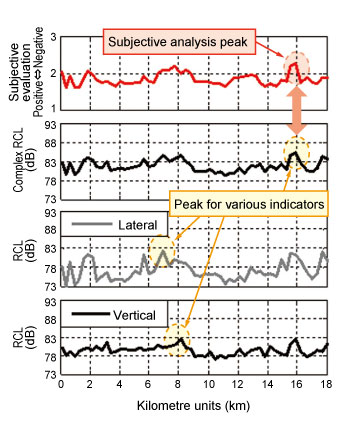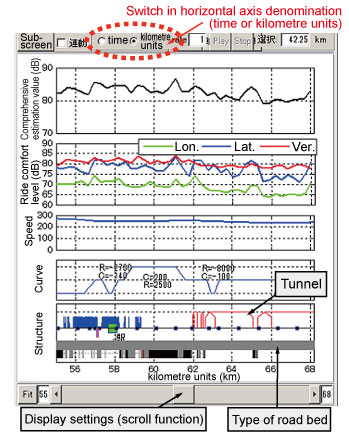3. Method for evaluating ride comfort influenced by complex vibration
- In order to predict change in ride comfort due to complex vibration, a method was proposed for obtaining an integrated estimate value, which is deemed to be a close representation of the physically perceived ride sensation.
- A system was then devised which analyses and gives a holistic view of ride comfort related information.
The general approach to assessing ride comfort until now has been to analyse vertical/ lateral/ longitudinal vibrations separately. However, real passengers do not perceive isolated vibrations they only perceive the holistic effect of complex vibration.
Consequently a proposal was made to find a gcomplex ride comfort level (complex RCL)h of the combined effect of vibrations, with a view to obtaining an estimate which was as close as possible to real ride comfort (subjective evaluation) perception (Fig.1). Complex RCL is calculated on the basis of all three directional vibration accelerations filtered by sensory characteristic weighting curves. Since this output can be calculated in relation to time and correlated with location it is possible to break the value down to exact locations where ride comfort is poor.
An analysis and unified display system was subsequently developed to make it possible to analyse the sources of the poor ride comfort that had been located with the comprehensive indicators (Fig.2). Various types of information underlying ride comfort and the complex RCL (directional vibration component, track information, structural information, various images, etc.) can be displayed together according to the location data. In addition, by incorporating measured data from track inspection vehicles and running tests etc., it is possible to display the changing data dynamically. Data for any point in space or time can thus be visually displayed, making it intuitively easy to understand; the results can also be useful for work in other related fields, e.g. passenger, vehicle or track research, aimed at improving ride comfort.

Fig.1 Example of estimated complex RCL
Fig.2 Screenshot example of unified analytical system